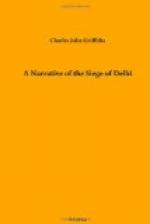From Kishenganj we rode through the Sabzi Mandi Gardens, visiting our old pickets there and at the Crow’s Nest, and then proceeded up the slope of the ridge to Hindoo Rao’s house. This was still garrisoned by the Sirmoor battalion of Goorkhas, some of whom escorted us round the place, pointing out the different positions they had so gallantly defended. The house was knocked to pieces, the walls showing evidence of the enemy’s fire, and revealing to us the truth of the saying in camp that these hardy little fellows, with the 60th Rifles, during more than three months, had been constantly exposed night and day to shot and shell, there not being a single part of their quarters where complete shelter could be found.
The Observatory, close to Hindoo Rao’s house, had also felt the effect of the enemy’s shot, while midway between the Observatory and the Flagstaff Tower, the Mosque—the only other building on the ridge—was also in ruins. Our batteries, nine in number, lay in a comparatively small compass, extending about three-quarters of a mile from the Crow’s Nest in the right rear to Wilson’s battery opposite the Observatory. The rest of the ridge was unprotected by guns in position, it being at so great a distance from the city and also free from the enemy’s attacks; the only danger and annoyance arose from occasional shells, which reached the camp and exploded amongst the tents, from round-shot and from rocket fire.
Passing by the Flagstaff Tower, we rode through the old camp, now desolate and silent, visiting the graves of our poor fellows at the cemetery, and then, retracing our steps, entered Delhi by the Kashmir Gate, and returned to our quarters.
Cholera still continued its ravages among the small number of troops left in Delhi. The reaction from a life of strife and excitement to the dull existence we were now leading had its effects on the men, and we each day lamented more and more that we had not gone with the Movable Column, leaving the noisome smells, the increasing sickness, and the monotony of Delhi behind. Two thousand sick and wounded had been moved into the Fort of Selimgarh, where the pure air and open situation of the place soon made a marked change in the number of invalids: but disease was rife among the regiments quartered in the city, and convalescents from Selimgarh were soon replaced by men suffering from cholera and fever ague.




